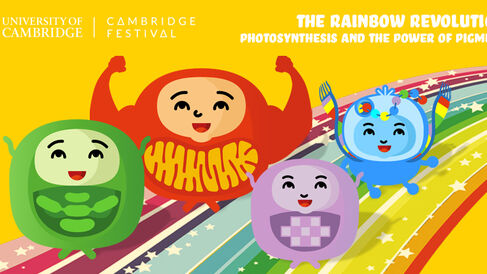
Join us on Saturday 2 April, 11am-4pm, in the Hopkins Building for a fun-filled day of hands-on scientific activities and games!
"Let there be light", or should that be "Let there be colour"? Early in the life of the Earth, our brown planet became a pigmented one. Life realised that light could be split into rainbows, its energy trapped and life on the planet powered. This was the photosynthetic revolution. The inventors were the simplest of cells, and the first steps were small. But life is cooperative and it loves to share. The power of colour was borrowed and exchanged. Cells merged with cells. Genes and recipes were swapped. Plants, trees, algae and seaweeds are the products of these complex partnerships with the first pigment-powered cells. And the sharing continues, from corals partnering with algae, to the formation of some of our deadliest foes.
Our Department studies many aspects of the rainbow revolution. At our Science Day, you'll join in the research and become a scientist with us! Together we'll explore the synthesis of the photosynthetic machine and investigate how we can exploit it for green electricity. We'll also discover how different organisms merge and trade technologies, and probe the dark side of sharing that resulted in malaria and similar diseases.
This free, interactive event includes hands-on experiments, informative demonstrations, and plenty of fun activities for children and adults of all ages!
Hands-on experiments and demonstrations
The light spectrum
Every ray of light contains a whole rainbow of colours. Learn which parts of the rainbow plants and algae use for photosynthesis.Photosynthetic algae and their plastid pigments
How does one collect light and look marvellous at the same time? Hear about plastid pigments and enjoy the rich greenness of Chlorella.Introduction to pigments
Can you tell where the colour in your food comes from? Find out in this interactive quiz about food pigments.Make a rainbow in a tube!
Ever wondered where a popcorn kernel or a penny would float in a rainbow? Take part in our experiment to learn how density is the determining factor!Glowing chlorophyll
Can you change a plant's colour from green to fluorescent red? In this activity, you will extract the green pigment from spinach leaves, purify it using a chromatography column, and then look at it under UV light.Chlorophyll absorbance spectra
A slightly different rainbow. See how extracted chlorophyll alters the light spectrum.An insect's eye view
Have you ever wondered how insects find the flowers they are feeding on? We will use a UV imager to give you an insect's eye view so that you can see it for yourself.Musical plants
Help us make a symphony of science! Learn about the musical (and electrical) power of photosynthesis in our interactive audio demonstration.Light wavelength and algal growth
Why are plants and fizzy water bottles both green? Find out with the results of our practical experiment on plant pigments.Making a bottle battery
It's 'current' affairs, but not as you know it! See how you can make green electricity from sunlight using some algae and recycled drinks containers.The Moss Table: a prototype piece of hybrid, natural-artificial furniture
It's green electricity in action! Marvel at the future of sustainable furniture power in this MOSSt see demonstration.DNA replication bracelets
Become an enzyme to understand how DNA replication (the production of two identical copies of a DNA strand) works. Instead of using actual DNA building blocks, you will be using colourful wooden beads to make a DNA sequence bracelet.The amino acid jigsaw
What are amino acids? What are proteins? Why do you need to eat protein? How do we make them ourselves in our bodies? Have a go at making proteins yourselves and be introduced to the machinery inside our cells whose job it is to make all the proteins that we need to be healthy.Protein structures in 3D
Ever wanted to see exactly what a protein structure looks like? Get up close and personal with macromolecules, proteins and DNA in 3D!The puzzle of plastid evolution
Did you know that complex cells are just like Russian dolls? Curious? Travel through time and see for yourself how cells evolved by getting stuck inside other cells, giving rise to a wonderful diversity of seaweeds, algae and corals, and some of our deadliest adversaries... Peer through a microscope and observe simple bacteria that learned to harvest light billions of years ago. Track fast-swimming dinoflagellate algae and solve the evolutionary puzzle of coccolithophores that formed the white cliffs of Dover.The Virtual Child
Did you know that artificial intelligence could be used to progress new cancer treatments? The Virtual Child platform aims to use this technology to identify completely novel treatment options for cancers in children. Find out more on the day from the CRUK Children's Brain Tumour Centre of Excellence Team!Tumour moulds
The CRUK Cambridge Centre Integrated Cancer Medicine Programme will be demonstrating how the use of 3D-printing of a tumour mould helps to sample tissue precisely. Marvel at Magnetic Resonance Imaging and see how the tumour moulds are produced. The 3D-printer will be printing on the day and some examples of the tumour moulds will be on display!
Social media
To keep up-to-date with all of our news for the Science Day, and to see how things are prepared behind the scenes, give us a follow on Facebook, Twitter and Instagram (@CamBiochem).
We'll be using the hashtags #BiochemDay2022 and #CamFest.
How to find us
Click here for details of how to get to the Hopkins Building. Information on the accessibility of the Department can be found here.
Pre-event survey
The Cambridge Festival has a new evaluation tool for this year. Please help us out by completing the pre-event survey before visiting our Department on Saturday 2 April.
